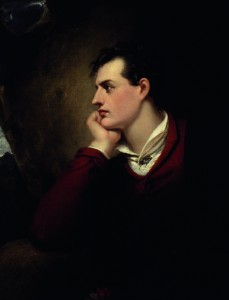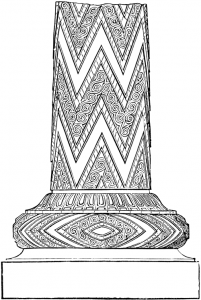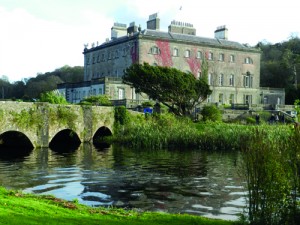Lord Sligo’s plunder of ancient Greece
Published in 18th–19th - Century History, Features, Issue 3 (May/June 2014), Volume 22
Lord Byron—in the spring of 1810 the 21-year-old marquis of Sligo visited him in Greece.
Southern Greece, August 1812—The marquis of Sligo, laird of Westport House, Co. Mayo, rocked back on his heels and whistled appreciatively. Like all members of his class, he had enjoyed a classical education and was familiar with the wonders of ancient Greece. And now he stood by the legendary burial chamber of Agamemnon, the king of the Greeks, who had commanded the likes of Achilles and Ulysses during their epic war against the Trojans 3,500 years earlier. The pillars that commanded the entrance to Agamemnon’s tomb were spectacular works, giant columns of green marble decorated with zigzag motifs.
The marquis turned to the man beside him and ordered him to proceed. With that, a group of men armed with pikes, shovels, saws and pickaxes began to wrench the priceless pillars from the place where they had rested for over a hundred generations. If the marquis felt any guilt at this act of wanton vandalism, it was presumably diminished by his conviction that these same pillars would look absolutely great in his stately pile back in Westport.
Visited Byron in Greece

Drawing of one of the pillars of Agamemnon—‘the most complete, as well as the most highly decorated examples known of the Mycenaean column’—which lay forgotten in the basement of Westport House until 1906, and which now flank the entrance to Gallery No. 11 of the British Museum. (Roy Winkelman)
Before Sligo’s arrival, Byron had visited Morea, as the Peloponnese peninsula in southern Greece was then called, and befriended Veli Pasha, the region’s cultured but corrupt governor. Veli had ‘honoured’ Byron with ‘a number of squeezes and speeches’, and gifted him a ‘pretty stallion’, but wisely did not invite the handsome poet to mingle with his harem of 60 women. On Byron’s recommendation, Sligo went to meet Veli. The British adventurer Lady Hester Stanhope, on meeting the Irish aristocrat during this time, noted that his eleven-strong entourage comprised ‘a Tartar, two Albanians [presented to him by Veli Pasha] superbly dressed in the costume of their country, with silver stocked pistols and silver hilted yatagans, a dragoman or interpreter, a Turkish cook, an artist to paint views and costumes, besides three English servants in livery and one out of livery’.
Following a picnic with Veli and, one presumes, the early nineteenth-century equivalent of a thick brown envelope, Veli gave Sligo the go-ahead to excavate the magnificent beehive tomb known as the Treasury of Atreus, where Agamemnon reputedly lay buried. The initial excavation work here had been carried out by Lord Elgin, another old Harrovian, whose name would forever be associated with the amazing marbles that he had controversially removed from the Parthenon in Athens a decade earlier.
There is an argument that Sligo, like Elgin, was simply preserving the monument from further vandalism. The pillars were already missing their capitals and bases, while one section had been hewn down and converted into a lintel for a nearby mosque. In any event, Lord Sligo now took ownership of the columns and arranged for them to be carried to his ship, the Pylades, upon which he had amassed a large quantity of vases and some 1,000 archaeological specimens from Morea and the Greek islands.
Getting the cargo home

Westport House
By June 1811 Sligo was in Malta, trying to find a suitable crew to negotiate the stormy seas. His solution was to cost him dear. As the Napoleonic Wars were in full flow, a British warship had docked in Malta. Sligo despatched his servants to meet with some of the warship’s crew and get them so drunk as to pass out. They were then instructed to bring their comatose bodies on board the Pylades. When they came to, the marquis offered them a new career on his ship, along with a wage that beat that of the Royal Navy, and false identity papers in case any trouble should arise. By this press-ganging tactic, he acquired at least two and possibly as many as eight of His Majesty’s able seamen. And so he and his battered ship set sail.
At length, rumours that the Pylades was manned by deserters from the Royal Navy began to be flashed all over the Mediterranean. A determined frigate captain gave chase to the ship and boarded. Sligo just had time to hide his deserters below deck. The marquis gave his word of honour that he had seen no deserters and the frigate captain relented. Fearing, however, that his stolen crew was too hot to handle, Sligo sent the men onshore at Patmos, a small Greek island in the Aegean Sea, and then sailed off, without warning, leaving them to their fate. The first man who made it back to safety spilled the beans and, for Sligo, the game was up.
Arrest and trial
He was arrested in Malta and brought back to London to stand trial on a charge of enticing British seamen to desert. He was still free to travel at this point and actually won 1,000 guineas in a bet when he galloped his coach from London to Holyhead in an incredible 35 hours. He was tried at the Old Bailey in December 1812. Sir William Scott, the judge, gave an impressive speech before finding him guilty. He sentenced his lordship to four months’ imprisonment in Newgate and a £5,000 fine. Lord Sligo ‘bowed, and was conducted by the keepers through the private door to the jail’. Amazingly, Lord Sligo’s widowed mother would marry Judge Scott on the day he was released.
Byron was dismayed when he heard the news. ‘I, who know him, do not think him so culpable as the navy are determined to make him. He is a good man.’ For his part, Sligo was already planning his next adventure, in which Byron was to play a central role. In March 1813, the poet wrote of Sligo’s ‘Persian plan’—‘he wants me to wait till September, set off and winter at Athens (our old headquarters) and then in the spring to Constantinople (as of old), and Baghdad, and Tahiran [Tehran]. This has its charms, too, and recalls one’s predilections for gadding.’
As it happens, their further adventures did not take place. As he matured, Sligo appears to have settled down to his duties as a landlord in County Mayo, introducing the linen industry to Westport. He was lord lieutenant of the county from 1842 until his death in 1845 and sat in the British parliament, where by 1838 he was regarded as ‘one of the most corpulent men’ in the House of Lords. The jury is still out on how culpable he must be for the atrocious loss of life in Mayo that took place during the Great Famine, shortly after his own death. He was also a busy father by his marriage in 1816 to Lady Hester de Burgh, eldest daughter of the thirteenth earl of Clanricarde, with whom he had six sons and eight daughters.
‘Emancipator of Slaves’
Lord Sligo’s greatest achievement was as governor of the British colony of Jamaica, to which office the ex-con was appointed by his old schoolfriend Bobby Peel in December 1833. Slavery had just been abolished throughout the British Empire and Sligo’s foremost task was to ensure that the plantation-owners behaved accordingly. He was well placed for the task because he and his family owned a number of plantations on the island. His policy to liberate the slaves initially went down like a lead coconut with his fellow plantocrats, who could not conceive how anyone could even think of paying black people to work. Nonetheless, the Mayo man pressed on with his reform programme, establishing the free town of Sligoville. By the time he left the island in 1836, the Jamaican people were hailing him as the ‘Emancipator of Slaves’.
As for the columns of Agamemnon’s tomb, they remarkably made it to the west coast of Ireland, where they lay in the basement of Westport House, their origin forgotten. In 1906 the sixth marquis identified the origin of the two great columns and gifted them to the British Museum, turning down an offer of £10,000 from the Berlin Museum. The grateful museum acknowledged the gift as ‘the most complete, as well as the most highly decorated examples known of the Mycenaean column—the immediate ancestor of the developed Greek order’. The pillars now flank the entrance to the museum’s Gallery No. 11.
Turtle Bunbury is a freelance historian based in County Carlow. His The Glorious Madness—the Irish and World War One will be published by Gill & Macmillan in autumn 2014.
Read More: Early life
Further reading
R. Beaton, Byron’s war: romantic rebellion, Greek revolution (Cambridge, 2013).
C. Hitchens, Imperial spoils: the curious case of the Elgin Marbles (New York, 1988).
D. Jordan & M. Walsh, White cargo: the forgotten history of Britain’s white slaves in America (New York, 2008).
M. Parker, The sugar barons (London, 2012).
















